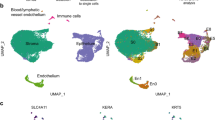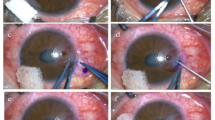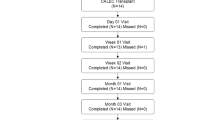Abstract
We describe the clinical management of 6 patients who developed a chronic corneal epitheliopathy 1–18 years after commencing soft contact lens wear. All had a history of exposure to thiomersal in contact lens fluids. The corneal changes were characterised by epithelial haze and superficial stromal vascularisation which extended from the limbus towards the visual axis. Five patients were observed for a minimum of 18 months after stopping contact lens wear before undergoing limbal transplantation. A good result was obtained in 1 patient who had worn a contact lens in one eye only. Recurrent epithelial changes were observed on the recipient eyes of the remaining patients who had previously worn contact lenses bilaterally, and in 1 patient epithelial haze also developed adjacent to the donor site in the previously clinically normal donor eye. All 5 patients experienced an improvement in symptoms post-operatively but in 2 patients the visual acuity later deteriorated because of epithelial irregularity. The sixth patient has not had surgery. We conclude that limbal stem cell dysfunction in chronic contact-lens-associated epitheliopathy may be subclinical and that autograft transplantation in bilaterally exposed patients may fail to restore the epithelial phenotype of the host eye whilst jeopardising the epithelial integrity of the donor eye by depleting its stem cell reserve.
Similar content being viewed by others
Article PDF
References
Bloomfield SE, Jakobiec FA, Theodore FH . Contact lens induced keratopathy. Ophthalmology 1984;91:290–4.
Kenyon KR, Tseng SCG . Limbal autograft transplantation for ocular surface disorders. Ophthalmology 1989;96:709–23.
Clinch TE, Goins KM, Cobo M . Treatment of contact lens-related ocular surface disorders with autologous conjunctival transplantation. Ophthalmology 1992;99:634–8.
Schermer A, Galvin S, Sun T-T . Differentiation related expression of a major 64K corneal keratin in vivo and in culture suggests limbal location of corneal epithelial stem cells. J Cell Biol 1986;103:49–62.
Cotsarelis G, Cheng S-Z, Dong G, et al. Existence of slow-cycling limbal epithelial basal cells that can be preferentially stimulated to proliferate: implications on epithelial stem cells. Cell 1989;57:201–9.
Zieske JD, Bukusaglu G, Yankauckas MA . Characterisation of a potential marker of corneal epithelial stem cells. Invest Ophthalmol Vis Sci 1992;33:143–52.
Huang AJW, Tseng SCG . Corneal epithelial wound healing in the absence of limbal epithelium. Invest Ophthalmol Vis Sci 1991;32:96–105.
Wright P, Mackie I . Preservative-related problems in soft contact lens wearers. Trans Ophthalmol Soc UK 1982;102:3–6.
Wilson-Holt N, Dart JKG . Thiomersal keratoconjunctivitis: frequency, clinical spectrum and diagnosis. Eye 1989;3:581–7.
Smolin G, Okumoto M, Friedlaender M . Tretinoin and corneal epithelial wound healing. Arch Ophthalmol 1979;96:545–6.
Ubels JL, Edelhauser HF, Austin KH . Healing of experimental corneal wounds treated with topically applied retinoids. Am J Ophthalmol 1983;95:353–8.
Tseng SCG, Hirst LW, Farazdaghi M, Green WR . Inhibition of conjunctival transdifferentiation by topical retinoids. Invest Ophthalmol Vis Sci 1987;28:538–42.
Tseng TSG, Farazdaghi M . Reversal of conjunctival transdifferentiation by topical retinoic acid. Cornea 1988;7:273–9.
Kruse FE, Chen JJY, Tsai RJF, Tseng SCG . Conjunctival transdifferentiation is due to the incomplete removal of limbal basal epithelium. Invest Ophthalmol Vis Sci 1990;31:1903–13.
Tseng SCG, Tsai RJF . Limbal transplantation for ocular surface reconstruction: a review. Fortschr Ophthalmol 1990;88:236–42.
Kinoshita S, Friend J, Thoft RA . Sex chromatin of donor corneal epithelium in rabbits. Invest Ophthalmol Vis Sci 1981;21:434.
Mackman G, Brightbill FS, Optiz JM . Corneal changes in aniridia. Am J Ophthalmol 1979;87:497–502.
Chen JY, Tseng SCG . Abnormal corneal epithelial wound healing in partial-thickness removal of limbal epithelium. Invest Ophthalmol Vis Sci 1991;32:2219–33.
Author information
Authors and Affiliations
Rights and permissions
About this article
Cite this article
Jenkins, C., Tuft, S., Liu, C. et al. Limbal transplantation in the management of chronic contact-lens-associated epitheliopathy. Eye 7, 629–633 (1993). https://doi.org/10.1038/eye.1993.145
Issue date:
DOI: https://doi.org/10.1038/eye.1993.145
Keywords
This article is cited by
-
Long-term ocular surface stability in conjunctivolimbal autograft and ocular surface safety in the donor eyes
International Ophthalmology (2024)
-
Recent Advances in Stem Cell Therapy for Limbal Stem Cell Deficiency: A Narrative Review
Ophthalmology and Therapy (2020)
-
Rat limbal niche cells can induce transdifferentiation of oral mucosal epithelial cells into corneal epithelial-like cells in vitro
Stem Cell Research & Therapy (2018)
-
Allogenic cultivated limbal stem cell transplantation versus cadaveric keratolimbal allograft in ocular surface disorder: 1-year outcome
International Ophthalmology (2017)
-
Characterization of the corneal surface in limbal stem cell deficiency and after transplantation of cultured allogeneic limbal epithelial cells
Graefe's Archive for Clinical and Experimental Ophthalmology (2016)



